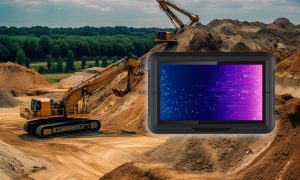Construction tablets are powerful computing devices tailored to meet the unique demands of the construction industry and beyond. With their rugged design, advanced features, and specialized software applications, these tablets serve as indispensable tools for construction professionals and workers across a range of industries. Let’s explore the diverse applications of construction tablets and how to choose the right one for your specific needs.
- Construction Industry: Construction tablets are extensively used in the construction industry for various tasks, including project management, job site documentation, blueprint viewing, and communication. Construction managers, engineers, architects, and contractors rely on these tablets to access project plans, collaborate with team members, and monitor progress in real-time, improving efficiency and productivity on the job site.
- Architecture and Design: Architects and designers utilize construction tablets for sketching, drafting, and modeling architectural designs. With precision stylus input and powerful drawing software, these tablets enable designers to create and modify designs on-the-go, facilitating rapid iterations and client presentations.
- Surveying and Mapping: Surveyors and GIS professionals leverage construction tablets for field data collection, mapping, and geospatial analysis. Equipped with GPS capabilities, mapping software, and rugged construction, these tablets withstand the rigors of outdoor environments, allowing surveyors to accurately capture data and generate maps in real-time.
- Civil Engineering and Infrastructure: Civil engineers and infrastructure professionals use construction tablets for infrastructure inspection, asset management, and maintenance planning. With specialized software applications for structural analysis, asset tracking, and predictive maintenance, these tablets streamline engineering workflows and ensure the integrity and safety of critical infrastructure.
- Facilities Management: Facilities managers and maintenance personnel employ construction tablets for facility inspections, maintenance scheduling, and work order management. Integrated with building management systems (BMS) and maintenance software, these tablets enable efficient facility management and proactive maintenance, reducing downtime and optimizing building performance.
Choosing the Right Construction Tablet: When selecting a construction tablet, consider the following factors to ensure it meets your specific requirements:
- Ruggedness and Durability: Choose a tablet with a rugged construction and high IP rating to withstand the harsh conditions of construction sites and outdoor environments.
- Processing Power and Performance: Look for a tablet with a powerful processor, ample RAM, and storage capacity to handle resource-intensive construction applications and multitasking.
- Screen Size and Visibility: Opt for a tablet with a large, high-resolution display and anti-glare coating for clear visibility and readability in bright sunlight or low-light conditions.
- Battery Life and Power Management: Select a tablet with long battery life and efficient power management features to ensure uninterrupted operation throughout the workday.
- Connectivity and Integration: Choose a tablet with a wide range of connectivity options, including Wi-Fi, Bluetooth, GPS, and cellular, to facilitate data exchange, communication, and integration with other devices and systems.
- Specialized Software Support: Ensure that the tablet supports specialized software applications relevant to your industry and workflows, such as project management, CAD/CAM software, or GIS applications.
By considering these factors and choosing a construction tablet tailored to your specific needs and workflows, you can maximize productivity, efficiency, and innovation in your industry or profession.














